The naked truth about Budapest’s thermal baths

Aug 7, 2024 • 9 min read

Swim past an art nouveau fountain at Gellért Baths © Will Sanders / Lonely Planet
Welcome to Budapest, the “World’s Spa Capital.” In this captivating, cultured city, nothing feels more relaxing than plunging into a thermal pool and soaking away your stress and worries in warm, muscle-melting, mineral-rich waters.
A landlocked country with an undying love for water, Hungary is blessed by naturally heated springs bubbling up from below the ground. With its famously elegant bathhouses, Budapest is a paradise for those seeking relaxation, healing and a bit of quirky local culture.
But these aren’t just any old baths – they’re architectural marvels, portals to the past, sanctuaries of wellness, social hotspots and a quintessential part of the Budapest experience. Whether you’re looking to cure what ails you or just soak up the local way of life, here's everything you wanted to know about Budapest’s thermal baths, but were too self-conscious to ask!


Budapest bathing across the centuries
Hungary is awash with thermal springs – there are more than 1000 in the country and more than 100 in Budapest alone, producing some 40,000 sq meters of warm, mineral-rich water every day. Before the Roman conquest, the area around present-day Budapest was inhabited by a Celtic tribe, the Eravisci, who named this land Ak-ink (Abundant Water).
Romans built the regional capital of Aquincum and quickly began taking advantage of Hungary’s thermal springs, as evidenced by the ruins of Roman bathhouses found around the country’s borders. The most notable spa in Aquincum was the Thermae Maiores (Great Bath) near Flórián tér in Óbuda, which had luxuries such as hot and cold piped water and underfloor heating.
But bathing only became an integral part of life in Hungary during the Ottoman Occupation in the 16th and 17th centuries. The Ottomans built elegant hammam-style baths consisting of octagonal pools topped by high-domed ceilings dotted with glass inlays, allowing rays of light to shine through and strike the water.
Two of these historic bathhouses – Rudas Baths and Veli Bej Baths – are still in use today, but most of Budapest’s other historic baths, such as Széchenyi Baths or Gellért Baths, were built in the 19th and 20th centuries, during Budapest's time as the second capital of the Austro-Hungarian Empire.

Soak or sip? The healing power of Budapest's waters
Many Budapest bathhouses boast about the healing properties of their waters. Bubbling up from a network of underground caves, the warm waters are rich in dissolved minerals such as calcium, hydrogen carbonate, magnesium, sodium, sulfate chlorides and metaboric acid. A mineral bath isn't just pampering and calming, it's also curative.
Studies have shown that bathing in mineral-rich water can help to relieve a number of health problems ranging from arthritis and muscle pain to slipped discs, circulatory disorders, nerve pain, respiratory illnesses, orthopedic issues and even hangovers – we've tried and tested this last one, and can confirm that it helps!
It isn’t just muscles and bones that benefit from the mineral-rich waters. Drinking the spa waters is said to boost your health from within, and locals swear by this. If you’d like to give this liquid treatment a go, visit the ivókút (drinking halls) of Széchenyi, Lukács and Rudas Baths. All three sell potable spa water for a small price, though it’s best to bring your own bottle.

Plan your visit: What to know before you go
When to go : Most baths operate year-round and are wonderful to visit in every season, but soaking outdoors in winter and watching the steam rise into the air while snow freezes your hair is the most magical experience. At weekends and during the winter holiday season, people pack into the baths like sardines, so for a more peaceful experience, visit on weekdays or early in the morning.
Opening times : Opening times vary depending on the day of the week and the bathhouse, and some baths now open at night on the weekends. The collective website www.spasbudapest.com has lots of useful information. Most baths have decent restaurants or a cafeteria, making it possible to spend a whole day there.
Family fun : Kids must be 14 or older to use the thermal baths as their cardiovascular systems can be affected by the high water temperatures. Pregnant women are also advised not to bathe in the thermal waters. For family-friendly swimming, try one of the city’s many open-air lidos instead.
Single-sex days : The Turkish bath section at Rudas holds single-sex days on weekdays (men only at set times on Mondays, Wednesdays, Thursdays and Fridays, and women only on Tuesdays), but the baths are open to all in high season – consult the website for specific times.
Nudity : Nudity is not permitted in public areas at any thermal baths in Budapest. On single-sex days, men are given drawstring loincloths and some women wear special apron-like garments, but most people prefer to wear a swimsuit.
Inside the baths : In most Budapest bathhouses, you'll find a series of indoor thermal pools ranging in temperature from lukewarm to piping hot, as well as colder pools for swimming laps. Other amenities include saunas, steam rooms, ice-cold plunge pools and indulgent spa services such as massages.
Outdoor bathing: Except for Veli Bej, all of the baths have an outdoor section with water fountains, whirlpools and wave machines. Always specify which services you need when you enter, as admission charges vary. Book ahead for additional spa treatments.
Fun extras: Fancy a beer bath, private bathing, a spa-rty or a night-time soak? Some baths offer quirky and fun experiences, so browse their websites for special services.

What to bring: Essentials for the Budapest bathhouse experience
Pack swimwear, a towel and flip-flops as the floor can be quite slippery. Swimming caps must be worn in the lap pools. Bathing accessories are available to rent or buy, but it’s better – and cheaper – to bring your own. Showers and hair dryers are available, so bring soap, shampoo and other personal cleaning products.
Upon entering a bathhouse, you'll be given a watch-shaped electronic bracelet that serves as a key to a szekrény (locker) or kabin (cabin) – a more private but pricier changing cubicle where you can leave your belongings. Some baths will allocate you a number, but generally, you can just take any that are available. Attendants are always around should you need any help. The outdoor pools at Széchenyi also offer smaller poolside lockers in case you want to take your wallet or phone outside.
Rules of (pruney) thumb: Know the local spa etiquette
Take a shower before plunging into the warm waters, and tie long hair back to avoid being told off by attendants. Keep the noise to a minimum, since it can be quite echoey inside. Remember, the baths are not the same as lidos and waterparks – some people are here to heal, so anything more than quiet chatting is frowned upon. Outdoor pools with waves and whirlpools are of course different and a more relaxed mood prevails.
Avoid soaking in the warm waters for too long because you might get light-headed. Signs by the pools specify the water temperature and may advise on how much time to spend inside – generally 20 minutes at a time. Remember to stay hydrated; drinking fountains are available at most baths, but note that eating and drinking are not allowed in the pools.

The best baths to visit
Which bath you decide to visit is a matter of choice, but the following are the ones we consider our favorites.
Gellért Baths
If you want to see a real Art Nouveau masterpiece, Gellért is your go-to. Colorful tiles and mosaics adorn the walls, the stained-glass windows and marble columns are jaw-droppingly beautiful and bathing here feels like a royal ritual.
The lowdown
Location : Buda side, next to Gellért Hill.
The vibe : Elegant and historic.
Selling points : The Art Nouveau design.
Open at night? No, closes at 7pm or 8pm in high season.
Our tip : Come early or book a private bathing session.
Széchenyi Baths
Széchenyi is one of the largest spa complexes in Europe, and probably Budapest’s most popular baths. It is exactly as epic as it sounds. Picture sunflower-yellow walls in a wedding cake-like building surrounding steaming outdoor pools, and the delightful sight of old chaps playing chess in the water. Regulars are happy to take on new challengers if you’re feeling brave.
Location: City Park (Városliget).
The vibe: Grand and lively.
Selling points: Lovely outdoor pools and the beer bath section.
Open at night? No. The baths close at 7pm or 8pm in high season, but a ticketed spa party with DJ music, light shows and drinks takes place here most Saturdays .
Our tip : Come early to beat the crowds or pay a little extra to relax upstairs at the less-packed Palm House.

Rudas Baths
Rudas has been around since the Turkish conquest of Hungary but the baths have been fully renovated with a contemporary touch. The biggest attraction is a rooftop hot tub providing a pretty view of the Pest skyline. This is the only bath that still holds single-sex days in its Turkish bath section.
Location: Buda side, by the foot of Elizabeth Bridge.
The vibe: Ottoman-era charm with a contemporary touch.
Selling points : The rooftop hot tub.
Open at night? Yes, on Fridays and Saturdays.
Our tip: Leave enough time to explore the various saunas, steam rooms and pools; note that the rooftop hot tub gets crowded during peak hours .
Lukács Baths
Lukács is the perfect destination for an authentic and tranquil thermal bath experience, offering a peaceful escape from the city’s more crowded tourist spots. The medicinal properties of its waters are backed up by marble memorial plaques installed in the adjacent park, giving thanks in various languages to the institution and its medical staff for healing therapies.
Location: Buda side, close to Margaret Island.
The vibe : Local and tranquil.
Selling point: A true haven of health .
Our tip: Lukács also offers a beer bath and there's a drinking hall where you can taste the healing water, sourced from a dedicated well.
Veli Bej Baths
Less crowded than the big-name baths, Veli Bej is a venerable choice combining historical charm with modern comforts. Built in the 16th century, Veli Bej was the most beautiful bath of its time, and the original walls and pipes can still be seen inside the modern building, but there are no outdoor pools.
Location : Buda side, near Margaret Island .
The vibe : Quiet and intimate.
Selling points : Ottoman-era history with modern facilities .
Open at night: No, closes at 9pm .
Our tip: Check the opening hours; the bath usually takes a technical break between noon and 3pm on weekends and only opens at 3pm on weekdays.
This article was first published May 8, 2019 and updated Aug 7, 2024.
Explore related stories

Jan 10, 2020 • 5 min read
Just because you don't drink doesn't mean you don't want a good night out. Here's our guide to the best nightlife for sober travellers in Europe's cities.

Jul 31, 2024 • 5 min read
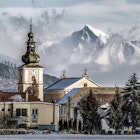
Jul 25, 2024 • 8 min read
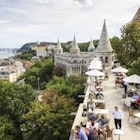
Jul 24, 2024 • 8 min read

Jul 22, 2024 • 5 min read

Jul 18, 2024 • 7 min read

Jul 18, 2024 • 6 min read

Jul 17, 2024 • 7 min read

Jul 16, 2024 • 7 min read

Jul 1, 2024 • 10 min read
Shopping in Budapest
Hungarian Dishes to Try
Best Restaurants in Budapest
Ruin Bars to Visit
Best Time to Visit
Weather & Climate
Budapest Airport Guide
Public Transportation
Neighborhoods to Know
72-Hour Itinerary
Day Trips From Budapest
Top Things to Do
Free Things to Do
Best Museums
Thermal Baths
The 6 Best Thermal Baths in Budapest
Known as the "City of Baths," Budapest sits on a fault line, and its thermal baths are naturally fed by 120 hot springs. The city is home to an impressive selection of thermal baths, many of which date to the 16th century. We've rounded up the best of the bunch including a sprawling neo-Baroque palace, a rooftop pool overlooking the Danube , and an ancient Ottoman bathing house that's open until 4 a.m. every Friday and Saturday.
Before you dive in, here are a few things to keep in mind: bathers are expected to wear a swimsuit at all times in Budapest's baths, and swim caps are mandatory accessories when swimming in the lap pools. Finally, bring flip flops! They're useful when walking between the indoor and outdoor pools.
In Budapest's baths, don't stay in the hot thermal pools for longer than 20 minutes; don't swim in the thermal pools if you're under 14; and don't smoke. Smoking is not permitted in any of the thermal baths, including the open-air spots.
Széchenyi Thermal Baths
Housed in a neo-Baroque palace in Budapest's City Park, Széchenyi is Budapest's largest thermal bath complex. Built in 1913, this sprawling site is home to 15 indoor pools and three huge outdoor pools of varying temperatures. Consult a map to make the most of your time at the baths as the maze-like complex can be a little tricky to navigate.
Inside you'll find saunas, steam rooms, aqua fitness equipment, whirlpools and jets, and outside you can relax in pools heated to 33 C (91 F) and 38 C (100 F) or swim laps in the main pool. The thermal water is high in calcium, magnesium, and hydrogen carbonate and is said to ease joint pain and arthritis and improve blood circulation.
Széchenyi is open year-round, and locals play chess on floating boards at the edge of the pool come rain, shine or snow. "Sparties" (spa parties) featuring DJs, laser shows, and film screenings are held on most Saturday nights until 3 a.m. throughout the summer.
Gellért Baths
With its mosaic walls and floors, stained glass windows and Roman-style columns, Gellért Baths is Budapest's most beautiful bathing destination. Opened in 1918, this Art Nouveau complex features indoor and outdoor baths fed by thermal springs from the nearby Gellért Hill. The temperature of the pools ranges from 26 C (79 F) to 40 C (104 F), and you'll also find dry and steam saunas, treatment rooms for medicinal massages, a carbonic acid bathtub (for cardiovascular issues and high blood pressure), and small thermal baths that can be booked privately by couples. The modern outdoor pool features a wave machine, and there's a large terrace for soaking up the rays in the summer months.
Rudas Baths
This Turkish-style bathing complex dates to the 16th century when Budapest was under Ottoman rule. The central octagonal pool sits under an atmospheric dome and there's a modern rooftop pool overlooking the Danube upstairs. The baths are open until 4 a.m. every Friday and Saturday for night bathing and water temperatures range from 11 C (52 F) to 42 C (108 F). There's a dedicated physiotherapy section for all sorts of thermal treatments, and, in the main hall, you can drink healing waters from the Hungaria, Attila, and Juventus springs.
Lukács Baths
While the Lukács Baths opened in the 1880s, it's said that the site's thermal springs date back to the 12th century. The baths are popular with locals and those seeking treatment for various ailments. Facilities include an infrared sauna, a steam bath, a Himalayan salt wall (to ease respiratory problems), and a weight bath (to treat spinal injuries). You can book a number of massages, reflexology sessions and medicinal treatments. The venue hosts "Sparties" (spa parties) until 3 a.m. on most Saturday nights throughout the winter that feature DJs, laser shows and film screenings.
Király Baths
While it may not be as grand as some of Budapest's spas, the Király Baths is a good and affordable option if you're looking for a traditional thermal bathing experience away from the crowds.
The Turkish baths date to 1565, and the main pool sits under a classic Ottoman dome dotted with skylights. The site was damaged during World War II and renovated in 1950. It now features steam baths, saunas, underwater massage jets, and pools fed by thermal waters from the nearby Lukács Baths.
Császár Baths
Built under Ottoman rule in the 16th century, this Turkish bathhouse was one of the most beautiful thermal centers of its time. You can still see some of the original stonework around its large octagonal thermal pool. There are smaller pools to relax in, all of varying temperatures, and there's a Jacuzzi, a hydrotherapy bathtub, and a wellness section for steam baths, saunas, and massage treatments. The building is home to both a hotel and a hospital for treatments based around water therapy.
Top 7 Hungarian Dishes to Eat in Budapest
10 of The Best Free Things to Do in Budapest
The Best 18 Things to Do in Budapest
February in Budapest: Weather, What to Pack, and What to See
The Top 10 Museums in Budapest
December in Budapest: Weather, What to Pack, and What to See
7 Things to Buy at Budapest's Great Market Hall
72 Hours in Budapest: The Ultimate Itinerary
Weather in Budapest: Climate, Seasons, and Average Monthly Temperature
March in Budapest: Weather, What to Pack, and What to See
November in Budapest: Weather, What to Pack, and What to See
January in Budapest: Weather and Event Guide
10 Reasons to Visit Budapest
Your Trip to Budapest: The Complete Guide
April in Budapest: Weather, What to Pack, and What to See
The 6 Best Day Trips to Take From Budapest

An Actually Useful Guide for Visiting Budapest’s Thermal Baths
There are a lot of things that I loved about my experience in Budapest, but one of my top experiences was soaking in the city’s famous thermal baths. Budapest is renowned for its thermal baths, which have been an integral part of its culture and history for centuries. If it is your first visit to Budapest, then a stop at one of 9 thermal baths in the city is an absolute must-do activity. They don’t call it the City of Spas for no reason!
The history of the thermal baths in Budapest can be traced back to the Roman era when the thermal waters and springs were used for medicinal purposes. Since then, bath culture has played a significant role in Hungarian society. The thermal baths in Budapest hold a special place in Hungarian culture and are considered more than just places to unwind. For locals, it is a customary ritual to visit the baths regularly, especially on weekends or after work. These baths offer a sense of community, where people from all walks of life gather to socialize, chat, and connect while enjoying the healing properties of the mineral waters.
If you’ve been following this blog for a while, then you know how much I love visiting spas and saunas around the world. The obsession started after a trip to Finland , and has only grown since. After experiencing the Hungarian thermal bath culture, I am sharing all my tips to best enjoy it. There are some cultural practices and customs that you should know before visiting to make the most of your time at Budapest’s thermal baths.
What You'll Find In This Post
Everything You Need to Know About Visiting Budapest’s Thermal Baths
What to expect at the thermal baths, best time of year to visit.
There 9 thermal baths around Budapest, and a majority of them are open year round. The most famous (and Instagrammable) is Szechenyi Baths, but all of them are incredibly popular with locals and tourists alike. We visited Budapest in late April which was actually perfect. The outside air was cool enough but not frigid and the pool waters were a lovely warm!
How Long Does It Take?
For a true thermal bath experience, you will usually stay at the pools for a few hours. This allows you to soak your skin deeply and cycle through the sauna cycle (hot/cold/rest) a few times. My average visit is around 2 hours when I go to a thermal spa.
Days & Times of the Week
Most of Budapest's thermal baths are open daily from early until relatively late. Sometimes they even host special evening events! Try to arrive to any thermal baths as early as possible to enjoy the water in relative peace and quiet. Szechenyi opens as early as 6am. As the day progresses, more and more visitors will trickle into the baths, with the crowds really starting around 10:30am. By the mid afternoon it can get so crowded that you are bumping into people! Not a relaxing atmosphere…
Sulfer Smell
Will it really smell like sulfur the whole time?
Yes… but not that bad. Really! The smell of thermal baths in Budapest were nothing like some of the natural hot springs I experienced in Iceland or Bolivia , and it is much more toned down. Plus, the minerals are great for you! My husband has eczema, so he normally hates visiting pools because the chlorine hurts his skin. What is so great about thermal waters is that the water contains all sorts of natural minerals like sulphite, sodium, calcium, and magnesium which make the skin feel fantastic. You’ll come out feeling energized and rejuvenated -- hence why Hungarians have been visiting them regularly for two millenia!
Types of Pools at Budapest Thermal Baths
Indoor pools.
At most of Budapest’s baths, you’ll find a mixture of indoor and outdoor pools as well as other amenities such as saunas and steam rooms. Typically there is an “exercise” pool indoors, which you’ll see people swimming laps in. This is where you need to wear a swimming cap.
Outdoor Pools
The more “relaxing” pools will usually be both indoors and outdoors, but the outdoor pool typically is the largest and most popular. The pools will be a variety of different temperatures, so keep an eye out for signs that indicate the temperature. The baths themselves aren’t terribly hot, usually maxing out around 40 C.
To get a serious sweat going, be sure to visit the saunas or steam rooms in between pool soaks. Saunas offer a dry and hot experience while the steam rooms are extremely humid and steamy. Similar to the pools, there are different saunas at different temperatures, and there will usually be a sign indicating the heat . What I learned from my sauna experience in Finland is the ideal way to sauna is to do a hot sauna then a cold plunge then a short rest either outside or in a body temperature pool. This is the best combination for your circulation and skin, which is where the Hungarians say the health benefits come from.
Don’t stay in any sauna for too long or you’ll overheat. What I learned from my experience in Finland is the ideal way to sauna is to do a hot sauna then a cold plunge then a short rest either outside or in a body temperature pool. This is the best combination for your circulation and skin, which is where the Hungarians say the health benefits come from. As such, it’s best to know where the cold plunge pool is before you venture into the sauna, so you can easily go from the hot sauna to the cold plunge.
Packing for Budapest Thermal Baths
What to wear.
In the baths, you just need to wear a swimsuit. Some of the thermal baths have swimming areas that require you to wear a swim cap, but they are unnecessary for lounging in the baths. Bring your towel, flip flops, and robe with you from the locker room area and deposit them on a hook, bench or chair before you hit the water. You’ll want them close by, especially if you visit one of the outdoor pools in the winter!
What to Bring
You can rent most of the things listed below if you forget it, and then you just turn them in at the end. Each item will be priced individually, and it can add up. If you’re on a budget, I would recommend trying to bring your own. Don’t forget your swimsuit because they typically don’t rent those!
- Goggles + Swimcap (required if you want to swim in pools, especially at Gellért)
- Plastic bag or wet bag to put your swimsuit in at the end
- Backpack or Tote Bag
Storing Your Things
Most of the baths have cabins in the locker rooms. These are essentially private changing booths that lock. They comfortably fit one person and a small bag, or a little uncomfortably two people. These cost a little bit extra (around $2-$4) but are very secure and offer some privacy for those who want it. We opted for a cabin at all the baths we went to. If you are ok with a little general nudity feel free to skip the extra cost and just use one of the many lockers in the locker room. These are separated by gender.
Costs of a Thermal Bath in Budapest
Entry fees vary depending on the bathhouse and the services you wish to access. Some baths offer single-entry tickets, while others may have different packages or time-limited tickets. The prices are pretty reasonable, ranging from 10-25 euros in total for up to a half day visit. There will be extra services, such as massages, offered at most thermal baths. If you want to take part, you’ll need to purchase and reserve the services when you get your entrance ticket.
When you buy your ticket and services at the entrance booth, you’ll be given a little plastic wristband that has an RFID tag in it. It’s really important not to lose this, as it grants you entrance into the thermal baths. It also functions as your “credit card” while you make purchases within the thermal baths. These bracelets are very expensive if you need to replace it, so put it to your wrist securely.
We did a couples massage at one of the Budapest baths, and it was ok. The service is curt and straightforward with quite basic products and no music or ambiance. While the massage was decent, it was nothing to write home about. I guess that is to be expected when the therapists see hundreds of people a week. I would say skip it and save the money.
Most of the baths have bars or small cafes in them if you get thirsty or want a beer, and you’ll be required to scan your bracelet. You’ll scan and turn in the bracelet when you leave the baths, and if you got any extra services during your visit, you’ll be charged at the end.

Best Budapest Thermal Baths to Visit
Széchenyi thermal baths.
By far the most famous of the thermal baths in Budapest, Széchenyi is the place to go if you only plan on visiting one of the spas in Budapest. You’ll certainly have seen the stunning yellow facade on your Instagram feed at least once or twice. More than just a pretty package, Széchenyi is a sprawling facility with 18 different pools and an equal number of saunas. You could spend a day at this place if you wanted! I would recommend at least 1-2 hours for your first visit however. If you want some serious inspiration for the beauty of Szechenyi, Hello JetLag has some stunning photos!

Rudas Baths
Are you looking to soak in thermal waters while watching the sunset over Budapest? Then Rudas is your place! Their main outdoor pool offers a sweeping and stunning view over the Danube River and central Budapest. Just take a scroll through the geotag on Instagram for some inspiration! Plus, they offer a poolside bar if you want to drink and relax while at the spa.
Gellért Thermal Baths
Located on the Buda side of the Danube river, Gellert is an art deco dream with beautiful mosaics adorning the entire facility. It is much smaller than Széchenyi but it feels a lot less touristy. There is definitely a more local vibe at Gellert. A majority of the pools here are indoors, although their main outdoor pool is lovely.

Have thoughts or questions about visiting Budapest’s thermal baths? Tell me in the comments!
Share this story
FIND SIMILAR POSTS

12 Best Independent Boutiques to Shop Local in Budapest

My Blogging Journey and How I Built Traverse Blog


Everything You Need to Know About Skiing in Breckenridge
Thank you for this description of the thermal baths in Budapest, it is really helpful 🙂
I have just one question please, do you recommend that I buy the tickets online before I go or is it possible to buy them at the entrance to the bath?
P.S. I am planning to go there in April
Thanks in advance
Hi Ali! Thank you for your question and I am glad this article was helpful. I bought my tickets at the entrance, and didn’t do any online or advance tickets. However, that was in pre-covid times. I would assume it is probably different now, so you might want to book ahead just to make sure. I hope you have a great trip to Hungary!
Cancel reply
Your email address will not be published. Required fields are marked *
Save my name, email, and website in this browser for the next time I comment.
By using this form you agree with the storage and handling of your data by this website. *
- Privacy Policy
- Disclosure Policy
- Work With Me
- Guest Post Guidelines

- Destinations
- North Carolina
- Travel Tips
Select Page
A Guide to Budapest’s Thermal Baths
Posted by Annick Lenoir-Peek | Updated on Jan 18, 2024 | Published on Aug 31, 2023 | Hungary , Travel Blog | 0
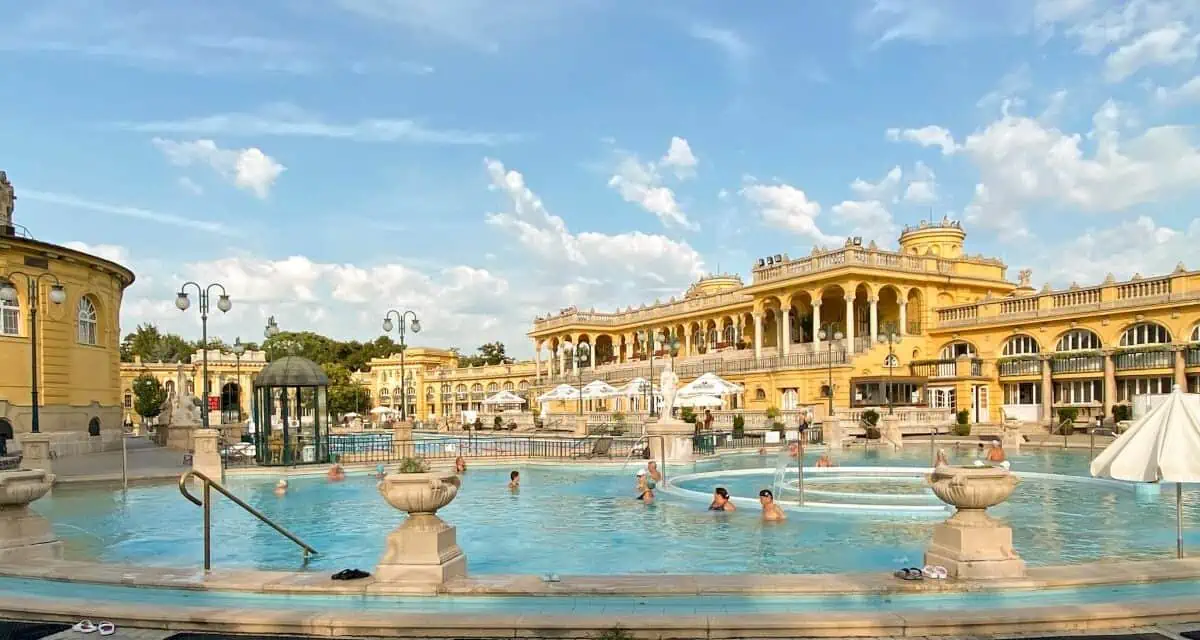
We may earn money or products from the companies mentioned in this post.
After experiencing Iceland’s famous lagoons, I couldn’t wait to try the famous Budapest thermal baths. The baths are based on the historic baths started by the Romans and made famous by the Turks centuries ago. So pack your bathing suit, swim cap, and slippers to enjoy the baths!
Budapest is famous for its thermal baths, and they are an essential part of the city’s culture and relaxation scene. Here, I’ll describe and compare three of the most famous baths in Budapest, followed by a brief description of additional options. I’ll even recommend how to visit them if you want to try to see all of the Budapest thermal baths during your Budapest trip.
The Three Most Popular Budapest Thermal Baths

Szechenyi Thermal Bath
Széchenyi is the largest and one of Budapest’s most well-known thermal baths. It is located in City Park and is distinguished by its beautiful Neo-Baroque architecture.
The bath complex offers indoor and outdoor pools with varying temperatures, ranging from cold to hot. The outdoor pools are especially popular, allowing visitors to enjoy a relaxing soak while surrounded by stunning architecture and greenery.
Széchenyi also features saunas, steam rooms, and various wellness services. Due to its size and popularity, Széchenyi can get crowded, especially on weekends and during peak tourist seasons.

Gellert Thermal Bath
Gellért is another iconic thermal bath on the Buda side of the city, near the Gellért Hill and the Danube River. The bathhouse is part of the Gellért Hotel and features an impressive Art Nouveau style. The main hall, with its colorful mosaics and stained glass windows, creates a unique and visually appealing ambiance.
Gellért offers a mix of indoor and outdoor pools with different water temperatures and mineral compositions. It also provides various spa and wellness treatments, making it an attractive choice for those seeking a more luxurious and tranquil experience.

Rudas Thermal Bath
Rudas is one of the oldest baths in Budapest, with a history dating back to the Turkish occupation in the 16th century. Located at the foot of Gellért Hill, Rudas offers a more authentic and historic bath experience.
The central octagonal pool, covered by a stunning dome, is the main highlight of Rudas. It retains its traditional Turkish architecture and atmosphere, providing a unique glimpse into Budapest’s past.
One of Rudas’ distinguishing features is the availability of night baths on certain days, where visitors can enjoy the thermal waters under the stars. Rudas also offers a rooftop pool with panoramic views of the city, making it one of the best places in Budapest to enjoy the sunset.

Comparing the Three Most Popular Budapest Baths
Size and crowds.
Széchenyi is the largest and most famous bath, meaning that it can get crowded, especially during popular times. Gellért is also popular with tourists but gets less crowded than Széchenyi. Rudas is smaller and generally less crowded, though the rooftop pool is often crowded, and there is not much room on the rooftop for lounging.
Indoor and Outdoor Pools
All three locations offer both indoor and outdoor pools. Széchenyi’s outdoor pool area is large and a beautiful setting often used in movies. Gellért’s elegant outdoor pools showcase fantastic decor. Rudas’ outdoor pool is smaller and a no-frills experience, though it offers stunning views.
Wellness Services
If you’re looking for varied and unique spa treatments and wellness services, opt for Gellért. Rudas offers essential spa services, like massage. Széchenyi, due to its larger size, offers many spa and wellness services, including a beer spa.
A ten-minute walk separates Gellért and Rudas baths. If you’re planning to go to Budapest thermal bath hopping, you could easily schedule a visit to these two back-to-back.

Other Budapest Thermal Baths
Budapest has several more to offer if you prefer a less popular (and less touristy) thermal bath.
Located on the Buda side of the city, just north of the Margrit Bridge, Lukács is open daily from 7 am to 7 pm. The bath hosts parties at night. One of the unique features is the Drinking Hall, where guests can purchase healing water to take home or consume on-site. The healing water is calcium-magnesium-hydro carbonate and sulfate-chloride thermal water containing sodium, which has a significant fluoride ion content. It is recommended for people suffering from gastric issues.
This co-ed bath focuses on its traditional Turkish roots. One of the unique features is that the cafe is accessible from the baths. Irgalmasok is open from 3 pm to midnight most days. Tickets can only be purchased from the cashier.
Both Lukács and Irgalmasok are steps away from each other, so if you’re looking to go Budapest thermal bath hopping, plan to visit them on the same day.
Family Friendly Options
The following Budapest thermal baths are more family-friendly with either dedicated hours or children-friendly areas:

Budapest Baths Etiquette
Like anywhere else that includes saunas, pools, and steam baths, Budapest’s thermal baths have etiquette rules that all visitors should follow.
- With few exceptions, children are not permitted in the baths. Generally speaking, unless there is a medical necessity, visitors to the Budapest thermal baths need to be over 14 years old to enjoy the springs.
- Several of the facilities have hours designated as single-sex. During the single-sex hours, many patrons will be in the nude. Swimsuits are required if the hours are set as open to both sexes.
- Like most places where people enter communal waters, guests are expected to shower before and after enjoying the baths using hot water and soap. Showers before soaking help ensure that the mineral spring waters remain clean for everyone. Showers after the baths help wash away the minerals that may sit on your skin.
- Bring your refillable water bottle. Drink from the fountains at the entrances and throughout the facilities. You’ll get dehydrated without noticing it, so water is critical!
- You must wear slippers (flip-flops or slides) when walking around the facilities. This helps to reduce the issues of foot fungus. You’ll be required to purchase some if you don’t bring your own.
- For guests with long hair, hair must be kept out of the water, usually using some elastic tie. The mineral waters can damage your hair, so you’ll want to abide by this rule! If you plan to do some laps in the swimming pools, you must wear a swim cap.
Most facilities have items for purchase or rent (think towels, bathrobes, slippers) but check on their websites in advance if in doubt.

Final Thoughts on Budapest’s Thermal Baths
Each bath has its charm and character, catering to different preferences. For a grand and social experience, Széchenyi is the most popular choice for visitors. For a touch of elegance and luxury, Gellért is a popular pick, especially for those staying on the Buda side. And for those seeking a more historic and intimate atmosphere, Rudas is an excellent option. No matter which one you choose, enjoying Budapest’s thermal baths is a must-do experience.
Check out these other Budapest posts:
- Best Places to Watch the Sunset in Budapest
- 15 Best Souvenirs From Budapest
- 10 Hungarian Foods (+ Drinks) to Try
Happy travels, Annick, The Common Traveler
Save this “Guide to Budapest’s Thermal Baths” for later – pin and share it!

Related Posts

The Ultimate Alaska Cruise Packing List for 2024
Updated on Jun 9, 2024 | Published on Sep 12, 2023

10 Things to Do and See in San Antonio: a Weekend Plan
Updated on Feb 23, 2024 | Published on Sep 12, 2018

Tips for Visiting Venice Italy
Updated on Jan 15, 2024 | Published on Jul 11, 2023

How to Get to The Natural Pool in Aruba – even without a 4×4!
Updated on Mar 20, 2024 | Published on Jan 28, 2018
Share your thoughts with us! Cancel reply
This site uses Akismet to reduce spam. Learn how your comment data is processed .

Search hotels and more...
Destination.
Check-in date
Check-out date.

7 of the Best Thermal Baths in Budapest
Find out below which one of Budapest's thermal baths works best for you.
- Offbeat Budapest & Vienna
For thousands of years, locals have enjoyed the steaming, mineral-rich thermal water simmering beneath Budapest's surface. The remains of the Roman-era public baths, Thermae Maiores, are still visible , while some of the hammams that Ottoman Turkey built during its occupation of Buda-Pest continue to function as such (Rudas, Király, Veli Bej).
Another wave of bathhouse-building frenzy took place during Budapest's golden years under Austria-Hungary in the early 20th century. Unlike the snug hammams, these are vast, striking baths inside lavish Revival and Art Nouveau buildings, such as Széchenyi and Gellért Baths.

Why should I go to a thermal bath?
Science has yet to verify the healing effects of balneotherapy, the treatment of pain in thermal water; it’s possible that minerally water is a useful supplement to standard treatments, but there's insufficient evidence to prove it. So what’s all the fuss about thermal bathing then? Well, healing isn’t the only reason to soak yourself in hot water inside grand old buildings – bathing is also a great way to relax, reflect, and socialize.
In fact, social gatherings and information exchange have traditionally been central to Budapest bathhouses. This was especially true during the most repressive years of the Communist-era, in the late 1940s and 1950s, when hiding amid clouds of mist and the background noise of running water was a relatively safe refuge for covert political discussions.
But despite what you might think, the majority of Hungarians don’t regularly go to thermal baths. At the seven main baths featured below, about 75 percent of guests are tourists on average. Locals who do go to baths mainly consist of diehard regulars, and patients looking to treat ailments like rheumatoid arthritis and muscle pain. As an added incentive, the Hungarian national health insurance plan subsidizes these prescribed visits.
Budapest has a total of nine medicinal baths today (and 123 hot springs). While the water’s mineral content is comparable, each bath is unique in terms of its size, architecture, amenities, and the type of visitors it draws. Most popular and biggest of all is Széchenyi, located inside Budapest's City Park, followed by Gellért and Rudas. In turn, many locals seek out quieter locations with lower admission fees.
Know before you go
A swimsuit, a pair of sandals, and a towel are all you need to bring. And a swim cap in case you'd like to use the swimming pools, too. The general admission, which ranges from €20 to €30, includes the price of a small locker (you can also rent a cabin for a surcharge).
On weekends, baths operate at full capacity, meaning that people are packed like sardines. You'll do yourself a favor if you visit on a weekday (admission fees are also slightly lower then).
If you go to Széchenyi or Gellért, try to get there at opening (Széchenyi usually opens at 7 a.m., Gellért at 9) – that's when you'll find the local regulars and the baths won't be so crowded.
Like it or not, nudity is no longer accepted. Except for Rudas, all Budapest baths are coed and require a bathing suit. See details below on Rudas.
Bathing is a year-round activity, but soaking in steaming-hot water is especially reviving in the gloomy winter months, particularly in the outdoor pools (except for Veli Bej, all baths have both indoor and outdoor sections).
In most bathhouses, there's a labyrinthine system of lockers and changing rooms with few signs to help you find your way. Instead of losing your patience as you keep getting lost, think of it as part of the experience.
Water temperatures across the pools usually range from 30 to 40 degrees Celsius (86 to 104 Fahrenheit). The general admission also covers the use of cold pools, saunas, and steam rooms.
Some baths offer refunds for shorter stays. Tickets for less than two hours and afternoon-only stays are most common.
Many baths offer additional services like massages, private baths, and pedicures for an extra charge. Check the baths' websites below for the full list of amenities.
Thermal water enthusiasts can buy mineral-rich water to drink. Széchenyi, Rudas, and Lukács each have a thermal water fountain with sulfurous water for consumption (if you bring an empty bottle, you can also take some to go). Prices won’t set you back much: a glass costs about ten euro cents.
Except for Király, all bathhouses are wheelchair accessible.
#1 SZÉCHENYI Baths ( location ; Monday to Sunday 7 a.m. to 8 p.m.)

What’s unique about it? The Times Square of thermal baths. As first time visitors to New York City, you too may want to head to Széchenyi, just be sure to set your expectations. With 1.7 million annual visitors, 15 indoor pools and almost 3,000 sqm of water surface, the place on weekends can feel more like an amusement park than a thermal bath. Use the main entrance from Kós Károly sétány for a glance of the striking dome and the interior mosaics of this Baroque Revival building. Immersing yourself in the steaming outdoor pool during the winter months is especially memorable.
Percent of locals: 15%. Number of pools: 15 indoor, 3 outdoor. Coed? Yes, every day. Admission (adults): HUF12,000 / €30 (includes the outdoor pools).
#2 GELLÉRT Baths ( location ; Monday to Sunday 9 a.m. to 7 p.m.)
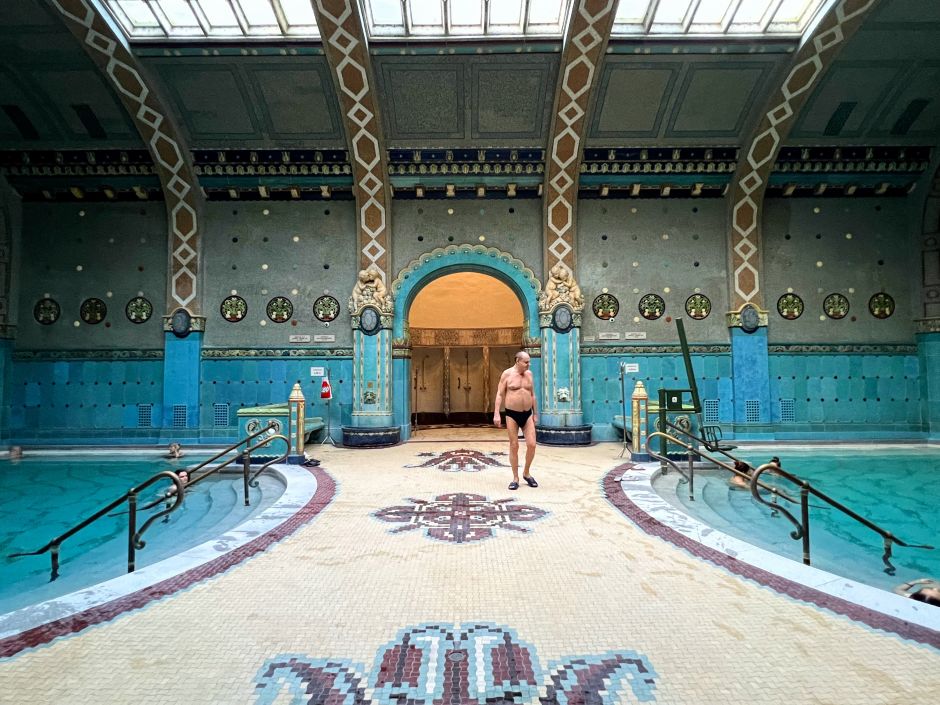
What’s unique about it? Budapest’s second most popular bath, after Széchenyi, is attached to Hotel Gellért, an Art Nouveau landmark from 1918. Expect Instagram-friendly indoor pools studded with turquoise glazed ceramics by Zsolnay that receive plenty of light through the sky windows (these pools are hidden in the back of the indoor bathing area). On weekday mornings, you can still mingle with locals here. Be sure to also visit the outdoor thermal pools, overlooking the Buda Hills and open year-round.
Percent of locals: 20%. Number of pools: 8 indoor, 2 outdoor. Coed? Yes, every day. Admission (adults): HUF12,000 / €30 (includes the outdoor pools).
#3 RUDAS Baths ( location ; Monday to Sunday 6 a.m. to 8 p.m.; night bathing on Friday and Saturday from 10 p.m. to 4 a.m.)

What’s unique about it? The dim, octagonal bath chamber was built under Ottoman pasha Sokollu Mustafa in the 16th century. On Monday, Wednesday, and Thursday and Friday mornings only men are permitted in the Turkish section (Tuesday is women's day, the rest coed). They saunter from pool to pool under the vaulted arcades wearing an apron-like cloth, kötény , covering little of their bodies. There's a newer wing open to all, which features an outdoor hot tub perched atop the building with sweeping views. It must be intentional that the water isn’t a few degrees warmer – people would never leave. Be sure your ticket covers both the indoor and outdoor sections and consider the 40-minute water massage service.
Percent of locals: 25% (on weekdays there are more locals). Number of pools: 11 indoor, 1 outdoor. Coed? After 1 p.m. on Thursday, after 11 a.m. on Friday and on the weekends. Details here . The wellness section and the outdoor hot tub are coed every day. Tuesday is “women’s day” at the Turkish pools. Admission (adults): HUF12,200 / €30 (includes the outdoor hot tub).
#4 LUKÁCS Baths ( location ; Monday to Sunday 7 a.m. to 7 p.m.)

What’s unique about it? Less bombastic than Gellért and Széchenyi, Lukács is a more straightforward bath frequented by many locals. Apart from the dim, labyrinthine indoor section, there are also swimming pools and a sunbathing terrace outside. Note the cluster of marble plaques on the side of the main building, commissioned by cured visitors as tokens of gratitude. Lukács has long been known as the bath patronized by local intellectuals.
Percent of locals: 50%. Number of pools: 4 indoor, 2 outdoor. Coed? Yes, every day. Admission (adults): HUF5,200 / €13 (includes the outdoor pools).
#5 KIRÁLY Baths ( location ; closed for renovation)
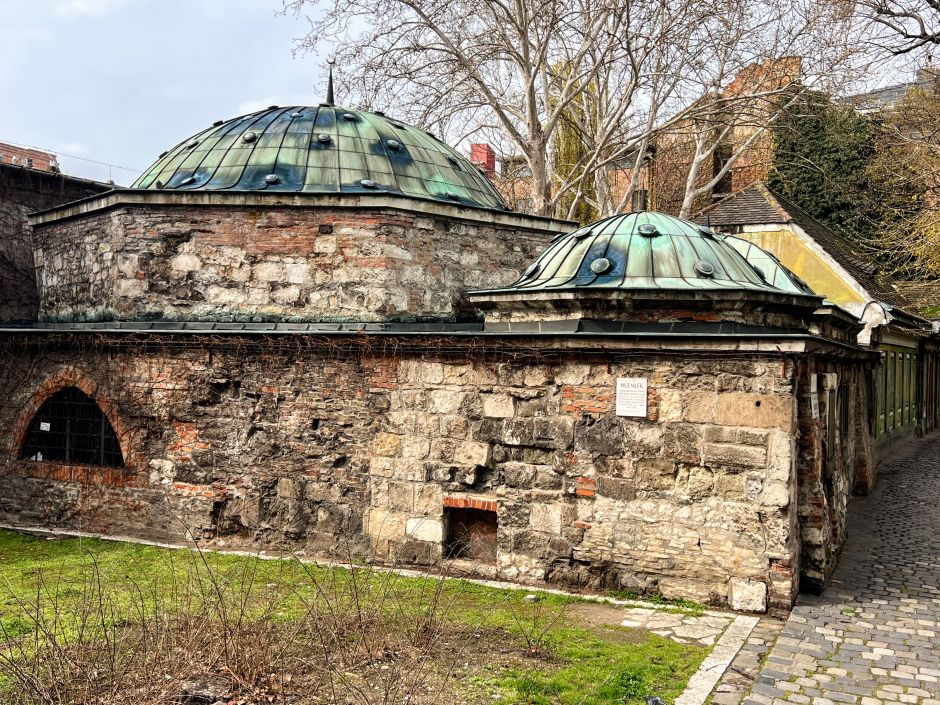
What’s unique about it? NOTE: Király is currently closed for renovation works. Part-Ottoman, part-19th century, Király is the smallest and coziest bath on this list. Using underground pipes, the Turkish pasha had it built away from its water source and within the city walls to ensure that bathing could continue uninterrupted even in case of a war. Visit also the snug interior garden with a wooden hot tub and several cots.
Percent of locals: 50%. Number of pools: 4 indoor (an outdoor hot tub during the warm months). Coed? Yes, every day. Admission (adults): Closed for renovation works.
#6 VELI BEJ Baths ( location ; Monday to Friday 3 p.m. to 9 p.m.; on weekends 6 a.m. to noon and 3 p.m. to 9 p.m.)
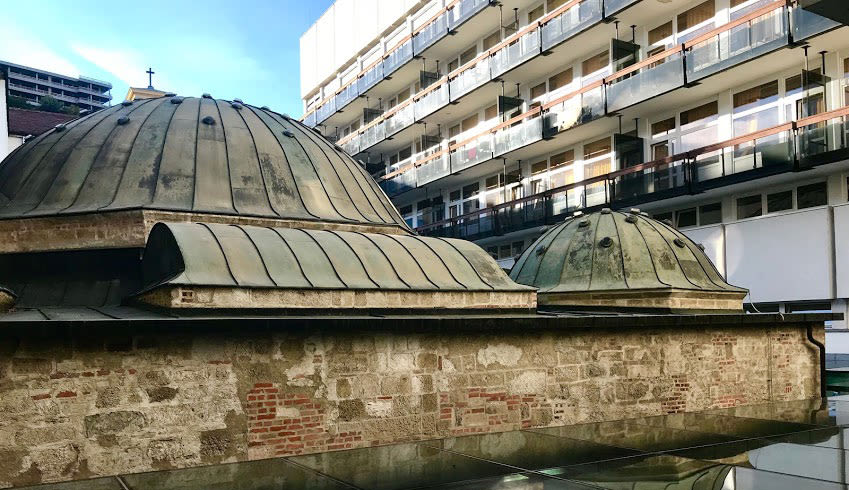
What’s unique about it? According to a 1673 chronicle, Veli Bej was the biggest and most gorgeous bath in Buda-Pest during the Ottoman-era. After a recent gut renovation, old and new harmoniously blend together: through Turkish domes and ogee arches leads the way to modern steam rooms and saunas. Veli Bej is managed by a Roman Catholic order, which doesn’t seem to run it for profit, making it one of the cheaper and least crowded options.
Percent of locals: 50%. Number of pools: 7 indoor. Coed? Yes, every day. Admission (adults): HUF5,000 / €13.
#7 DANDÁR Baths ( location ; Monday to Sunday 9 a.m. to 7 p.m.)
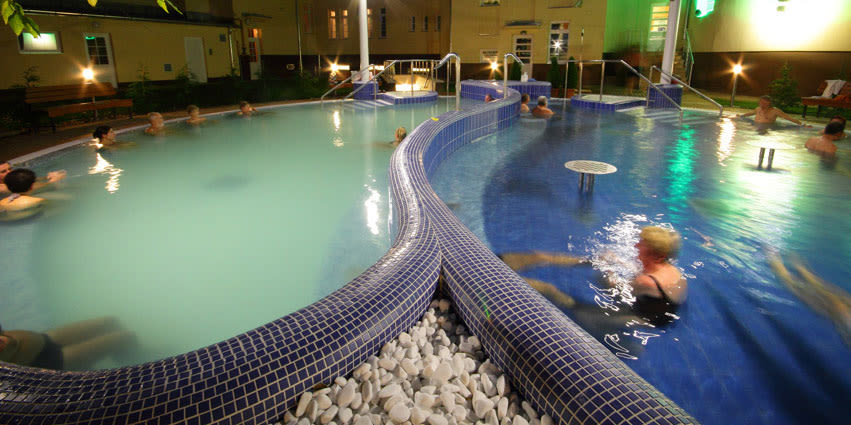
What’s unique about it? Dandár is located a bit outside the city center inside a 1930s Art Deco building. Drawing mainly locals, it comes closest to offering an immersive true-to-Budapest experience. The hot outdoor pool is best enjoyed during dreary winter evenings. Right next door is the production facility and the museum of Zwack Unicum , the iconic Hungarian herbal liqueur, with a gift shop in its entry hall.
Percent of locals: 90%. Number of pools: 3 indoor, 2 outdoor. Coed? Yes, every day. Admission (adults): HUF3,700 / €10 (includes the outdoor pools).
My content is free and independent. I rely in large part on readers to support my work. I'm grateful if you consider making a one-time payment ( PayPal , Venmo ).

The Essential Guide to Budapest’s Thermal Baths
This plunge primer will dampen your fears about coed nudity, tipping, and mean masseuses..
- Copy Link copied

You can enjoy the outdoor pools at Szechenyi even in the winter.
Shutterstock / Izabela23
For some, the mere mention of Budapest evokes images of steamy, tiled pools, tough-love masseuses, and lots of exposed skin. This is the City of Baths after all, and the 123 geothermal springs bubbling in caves under its hills and vales have soothed and healed locals, visitors, and even invaders since the Romans settled here nearly 2,000 years ago.
For those new to Budapest’s bathing culture, a few questions often come up: Do bathers have to be naked? Are men and women together or separated? What should I bring? How much does it cost? What about tipping? How does it all work? And, ultimately, is it worth it? Below, a rundown of their history, tips for visiting, and suggestions for our favorite baths in Budapest.
The history of Budapest’s baths
The original Roman baths remain only as archaeological sites, but they kicked off centuries of soaking. Hammam-style baths with octagonal main pools, like Rudas , date to the 150-year Ottoman occupation era (1541–1699). The century-old tiles and vaulted ceiling of the Gellért baths and the distinctive wedding-cake yellow palaces of the Széchenyi baths date to the late Austro-Hungarian empire and are grandly Beaux-Arts and neo-baroque. A smattering of Budapest’s bathhouses are much newer: The Danubius Hotel Helia and Aquincum , both contemporary hotel baths, have brought Budapest bathing up to date.

Széchenyi Thermal Bath is a historic bathhouse.
Courtesy of Visit Hungary
Taking the waters is an integral part of Budapest’s culture, and joining in is an instant lesson in understanding the Hungarian soul. While the therapeutic effects of the calcium-, magnesium-, and bromine-laden waters might be medically disputable, floating weightless in hot water in a subdued atmosphere is simply relaxing. And for Budapesters, communal baths have long been a place to both unwind and socialize; tales abound of communist-era whisper deals cut in a haze of thick, drippy fog.
Do you need to be naked?
No, nudity is not required. Budapest’s baths no longer allow it because most went coed within the past decade. The only places where bathers are expected to remove all of their clothing are the showers and the changing rooms. The one exception: Rudas bath, where men wear little aprons on men’s days, which are held every weekday but Tuesday, which is women’s day (women wear the same thing); weekends are for mixed crowds.
Who goes where?
In the vintage baths, especially Széchenyi, retirees often meet at dawn in the various saunas and springs to fulfill their “bath prescriptions.” (The water allegedly cures arthritis and other joint ailments, as well as pretty much everything else, according to balneology, the study of mineral hot springs and their medicinal effects.) But they’re also there to shoot the breeze and famously play floating chess in the steaming outdoor pools. It’s about community and tradition, wet and mostly undressed.
Younger couples or friends meet at Gellért, which was built in 1918 as part of the Hotel Gellért. With its beautiful art nouveau–style Zsolnay porcelain tiles, turquoise walls, and stained-glass windows, it’s an excellent example of Budapest’s vibrant early 20th-century bathing culture. Guy groups spend the men’s days lounging at the atmospheric Rudas, under a domed and vaulted interior built in the 16th century by an Ottoman pasha and in continuous operation since the year 1572. (It was tastefully renovated in 2014.)
When is the best time to go to a bathhouse?
Avoid the tourist rush and go to the larger baths as early as you can, even at 7 a.m., when most open. (Gellért doesn’t open before 9 a.m.) Or linger on Friday or Saturday nights at Rudas, which stays open past midnight. Or go where the locals go: Less ornate baths like Lukács are where Budapesters, especially the intellectual set, hang out. (Try the drinking water here, which apparently cures many ills, too.)
Is there a sulfur smell?
Yes, there’s a sulfur smell, but don’t let that stop you. At times, you may notice a mineral-y smell—some may say sulfuric. This is because the water in these baths is packed with, you guessed it, minerals. Calcium, magnesium, and sodium are big players and they can help ease symptoms of eczema, psoriasis, and other ailments. If you’ve been to Iceland’s hot springs , it’s far less stinky than that.

Szent Lukács Bath is like a scene out of a Wes Anderson film.
What should you bring to a thermal bath?
While all the following things are available to rent on-site, lines can be long and dispensed towels can be more like bedsheets than absorbent terry. So plan to bring along the following:
- Two good towels—one to use during the bath and one to dry off with after the last shower
- A swimming cap, if you intend to use a bath’s conventional swimming pool
- Your own soap and hair products; there are no spa-style dispensers here
- Sunscreen , especially if you’re visiting an outdoor pool during the summertime
- And lastly, a pair of flip-flops—floor tiles can be hot, and catching a foot fungus is no fun
What shouldn’t you bring?
There are a few things you’ll want to leave somewhere safe in the hotel room or Airbnb when you head off to the baths. Some of the places we’ve mentioned have private lockers, but some don’t—and you don’t want to spend the afternoon worrying about whether or not Grandma’s necklace is getting damaged by the water or steam.
- Outside food and drinks
- Cameras or other recording devices
Seriously, what do I do when I get there?
Shower before a bath session. Remember where your locker is, tie its key around your wrist or ankle, and then venture into the hazy maze with your towel in a waterproof bag.
It’s recommended to stay in a thermal bath for 20 minutes, then rest on a recliner. Or, alternatively, dip quickly into a cool pool or take a cold shower, both of which revive circulation and act as a “reset” for the next round.

The cultural experience of visiting Budapest’s grand spas, like Szechenyi, should not be missed.
Photo by Roman Belogorondov/Shutterstock
Work from medium-warm baths up to the hotter ones. Remember that 37 degrees Celsius is body temperature—in many baths, the temperature is marked in Celsius on tiles on the wall. The hottest is usually 40 degrees, or 104 degrees Fahrenheit. Relax and cool off in between.
Understand your body’s limits: If you feel dizzy, get out and cool down. Saunas and steam rooms are common, too.
Spa treatments are abound and you should indulge. Common treatments include massages, mud therapy, and soapy hammam sessions to literally beat or scrub the tension and toxins out of a weary body.
Most baths are quiet zones. Speaking is certainly not forbidden, but unless you’re in an outdoor area of a bathhouse complex, do keep conversations low. Some Hungarians call the baths “water monasteries” for a reason.
How much does it cost? Do I tip?
Entrance to most of the older thermal baths in Budapest costs between 4,000 and 8,000 forints (US$11–$22). The layout of larger baths like Széchenyi and Gellért can be utterly labyrinthine, and their price lists seem to follow the same baffling patterns—half- or full-day? With cabin or without? You can avoid some of it by booking in advance. Some established baths now offer online tickets, which saves time waiting in lines, and the separate costs are spelled out a little more clearly.
Tipping is welcome for the massage therapists and aestheticians providing other spa services like mud treatments—800–1,000 forints (about US$2–$3 ) will do it, and note you should tip before the service.
And never forget that, indeed, simply hanging out is what you’re here to do. Give yourself time, move slowly, breathe deeply, float, unplug. Listen to the lapping water and just think. Beyond the obvious soothing qualities of hot water, there’s a strange intimacy and sense of tolerance and ritual to the Budapest bath experience, one that’s clearly endured for many centuries and won’t stop anytime soon. Enjoy.

Gellért Thermal Bath is a tranquil place to rejuvenate.
Our favorite thermal bathhouses in Budapest
Some of our favorite baths in Budapest to visit include:
- Gellért Baths : Built in 1918 as part of the stately Hotel Gellért, this is a fine example of Budapest’s early 20th-century bathing culture.
- Széchenyi Thermal Bath : Budapest’s most popular thermal bath among locals and tourists alike, it’s also the largest spa complex in Hungary. It has multiple outdoor baths as well.
- Rudas Thermal Bath : Located at the Buda end of Erzsébet Bridge, this bathhouse has been welcoming bathers for upwards of 450 years. A rooftop pool has some of the best views of the city.
- Veli Bej : This bathhouse was built in the 16th century but recently renovated.
- Szent Lukács Bath : Known for the healing properties of its waters, this bathhouse also has specialty treatments, such as the Weight Bath used for stretching the back and spinal injuries.
This article originally appeared online in 2019; it was most recently updated on March 14, 2024, to include current information.


COMMENTS
Whether you’re looking to cure what ails you or just soak up the local way of life, here's everything you wanted to know about Budapest’s thermal baths, but were too self-conscious to ask! Historic bathhouses such as the Gellért Baths are architectural wonders.
The city is home to an impressive selection of thermal baths, many of which date to the 16th century. We've rounded up the best of the bunch including a sprawling neo-Baroque palace, a rooftop pool overlooking the Danube , and an ancient Ottoman bathing house that's open until 4 a.m. every Friday and Saturday.
There 9 thermal baths around Budapest, and a majority of them are open year round. The most famous (and Instagrammable) is Szechenyi Baths, but all of them are incredibly popular with locals and tourists alike. We visited Budapest in late April which was actually perfect.
Here, I’ll describe and compare three of the most famous baths in Budapest, followed by a brief description of additional options. I’ll even recommend how to visit them if you want to try to see all of the Budapest thermal baths during your Budapest trip.
While the water’s mineral content is comparable, each bath is unique in terms of its size, architecture, amenities, and the type of visitors it draws. Most popular and biggest of all is Széchenyi, located inside Budapest's City Park, followed by Gellért and Rudas.
From what to wear and expect to recommendations of the best thermal baths in Budapest, here is how to experience the Hungarian capital's bathing culture.